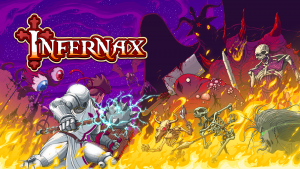
For twenty-seven years, the over-the-top violence of Mortal Kombat has won over the hearts of many teenagers, upset hordes of parents, and left the rest of us in awe about the goofy extremes of its cartoonish violence. While the gore and viscera have been a common link between the many iterations of this franchise, the quality of the core gameplay has varied dramatically. Luckily, Mortal Kombat 11 continues the series’ recent trend of balancing a weirdly engaging story-mode with solid central mechanics. The gratuitously violent and convoluted narrative is delivered with verve and sincerity, reconciling its campy roots with effective character moments. On the gameplay side, fundamental mechanics have been rethought for the better, like how meter has been divided into offensive and defensive bars, encouraging the usage of techniques that utilize each. MK11’s central offerings are quite strong, which is a good thing considering how some of its peripheral modes leave quite a bit to be desired. The plethora of unlockable cosmetics are gated begins the thoroughly tedious Towers, making for a grindy affair.
But let’s start with the good. Continuing the long-running, sprawling narrative of these games, MK11’s story is once again ostensibly presented as an absurd martial arts action movie where you get to control all of the fight scenes. It strikes that fine line between hammy and playing-it-straight, with ridiculous touches like the fact that “bad” Raiden has the red glowing eyes of a cartoon villain juxtaposed against genuine narrative beats like how two mortal enemies, Sub-Zero and Scorpion have managed escape an all-consuming cycle of revenge or how Jax is suffering from PTSD. Also, there are some time travel shenanigans, which set up for nostalgic callbacks, the return of dead characters, and display how everyone has changed over time.
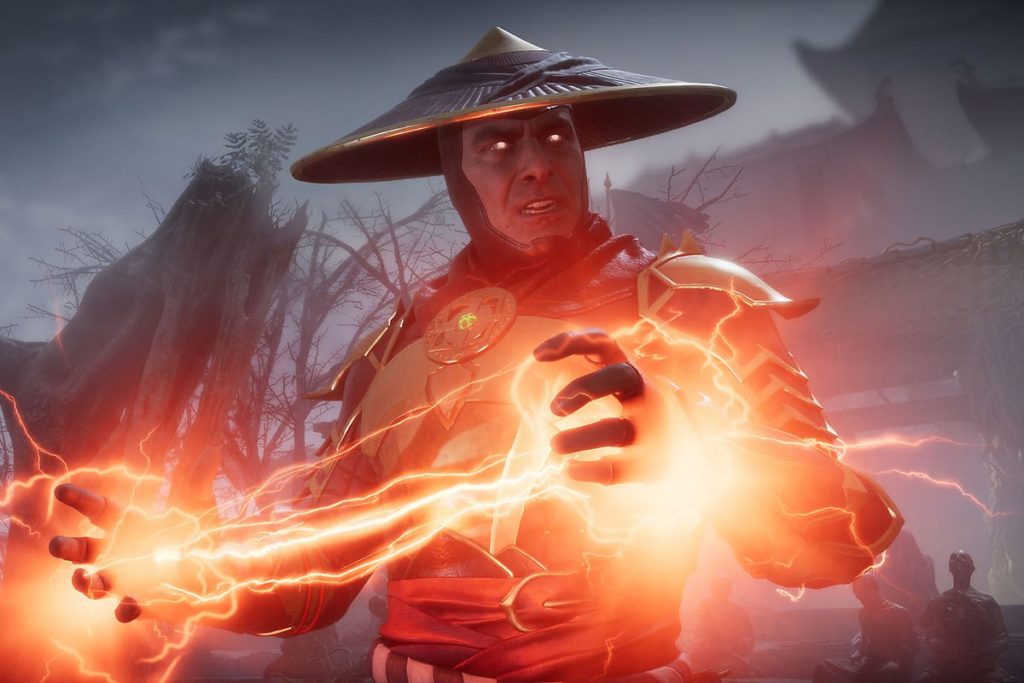
The story mode feels like a case-study in why Ludonarrative Dissonance doesn’t need to be game breaking. Trivial fights will break out, with characters stabbing each other in the lungs or stomping each other’s skulls in, only for them to both magically spring up mostly unharmed at the end of a fight. The various stops on this journey showcase a variety of improbable locations, like the hellish demon-infested bowels of Outworld, or robot-ninja assembly lines. But there’s such internal consistency to the tone of the mayhem, that amidst the excellently choreographed action, melodramatic confrontations, and cartoonish gore, it becomes clear that NetherRealms has honed their craft at creating delightfully campy video game stories.
But of course, beyond the saga of its story mode, there is the exceedingly important competitive aspect of the game. As previously mentioned, there have been several changes in MK11 to get around some of the issues with its predecessor. A lot of the changes center on bolstering the importance of neutral, which is a fighting game term that describes when neither opponent is hitting or comboing the other. Neutral is more important here than in MKX because of the reduction of combo length and the removal of sprinting. Since combos are less damaging and shorter, this means that more time must be spent jockeying for position and attempting to apply safe pressure on blocking opponents. The result of all of this is that the proceedings are far more skewed towards the interesting part of the game, that being forcing your opponent into disadvantageous positions, baiting out unsafe moves, and punishing with the best combos you have.
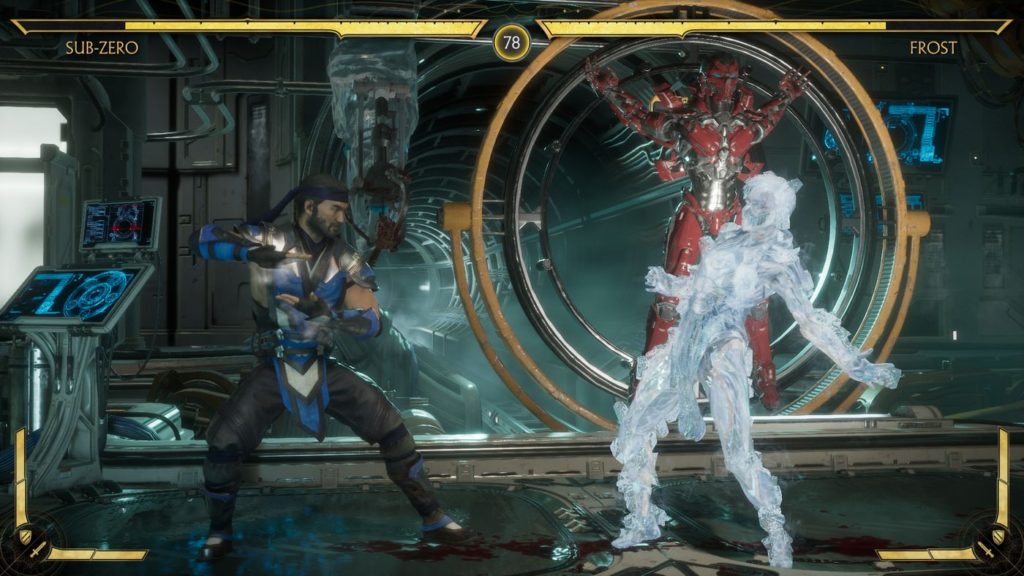
The changes around meter also tie into offering more opportunities for decision making, as by having two separate bars for offensive and defensive techniques, players are more likely to use both types of maneuvers instead of just always going for combo extensions. Offensive meter can be used to access powered up versions of moves that can extend combos and give more options in neutral. Defensive meter can be spent to grant more choices after getting knocked down or to provide the ability to escape air juggles. The plethora of mix-ups made available when getting out of knock-down, such as rolling or invincible getup attacks, turns the proceedings into a complex game of rock-paper-scissors, where you must win the mental game against your opponents by constantly mixing up your strategy.
In addition to meter usage, you must also manage a finite number of Fatal and Crushing Blows. Fatal Blows are extremely powerful attacks that only can be triggered when you’re low on health. If you land one successfully you won’t be able to use it again for the rest of the game. It’s a pivotal comeback mechanic, that doesn’t feel too overpowered due to the limit of one user per match, and its telegraphed startup. Additionally, there are Crushing Blows, which are attacks that cause a great deal of extra damage in certain circumstance. One universal example is that all characters will perform a Crushing Blow if they counter-hit a standing attack with an uppercut. However, these moves also can only be used once per game. In tandem with meter, the presence of Crushing and Fatal Blows add a significant element of constant decision making, as you must always balance the use of your resources to give yourself more chances to succeed. If you blow all of your important resources and still lose the round, then you are placing yourself in a very bad position for future rounds.
However, one drawback to the NetherRealms style of fighting game is that since most strings are made up of premade input sequences that don’t use links, there usually aren’t a ton of different combo starter moves. This in combination with the game’s nature as a four-button fighter makes the number of options in neutral somewhat smaller than many other fighting games. Also, a lot of characters have access to great zoning tools and long range moves that are mostly punishable after some degree of practice but are exceedingly annoying to deal with at first. Still, while I’m worried that the relatively small number of neutral options for some characters could threaten the longevity of the game, the abundance of wakeup-options, meter usage, and all of the other layers of mechanics have made it so that the mental battle of each match is still enticing after several hours of play.
To summarize the core gameplay, Mortal Kombat 11 feels like a neutral focused fighting game that allows players to quickly get access to the meaty part of the game, that being the part where you must read and outthink your opponents. The reduction of the importance of combos makes it feel like the experience is oriented around mastering countering opponent strings, safely applying pressure, and strategic resource usage. And the relatively small move-pool of most characters has the hidden benefit of making it much easier to adapt to your foes if they become overly reliant on certain moves. Thankfully, this strong core loop is flanked by a solid online play and a fantastic training mode.
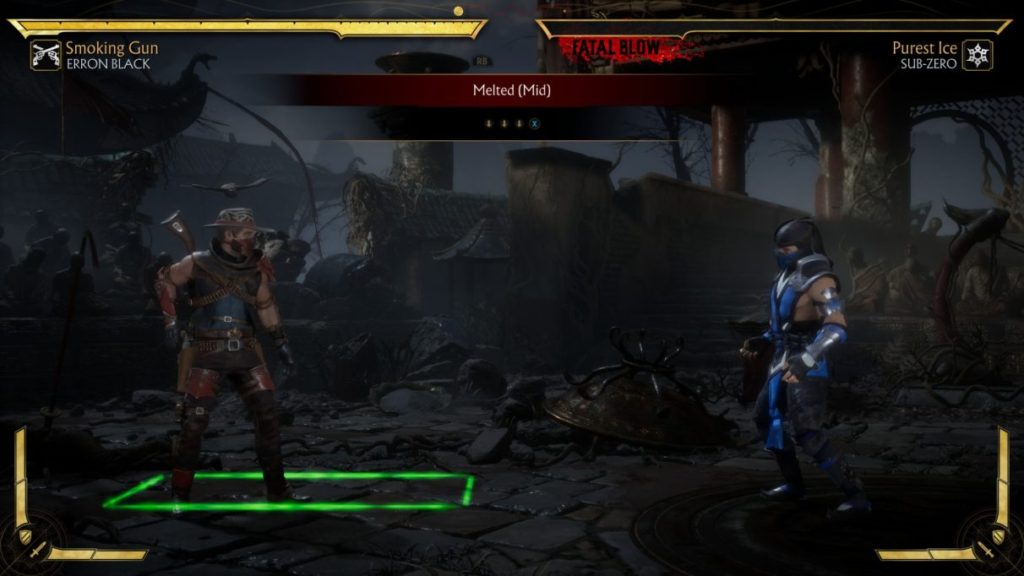
Before playing non-ranked online games, you get to see your opponent’s record and network connection, which helps avoid high-latency games, while also letting you choose the difficulty of your opponents. And the training mode is not only great for demonstrating the unique mechanics of this game, but also for explaining many general fighting game concepts. While most informational modes like this will give you a rundown on what all of the central mechanics are, this one actually explains when and why you should be using these techniques. This combined with the controller-friendly input scheme, fairly straightforward combos, and broad focus on the mental component of the game over raw tech skill make this both a great introduction to NetherRealms’ titles and also to the genre in general.
Lastly, I would be remiss if I didn’t mention the somewhat disastrous progression systems which attempt to railroad players into the least entertaining aspects of the game. While each character has a plethora of additional skins, configurable items, fatalities, victory poses, and more, the only way to unlock these items is by engaging with the Krypt or Towers. The Krypt transports the player to Shang Tsung’s Island, where you can explore the decrepit halls of many of the series’ iconic locations. There are also boatloads of chests, which hold all of the sweet customization options which allow for you to personalize your characters. However, this where the proceedings take a dismal turn, as the contents of the majority of these chests are completely randomized.
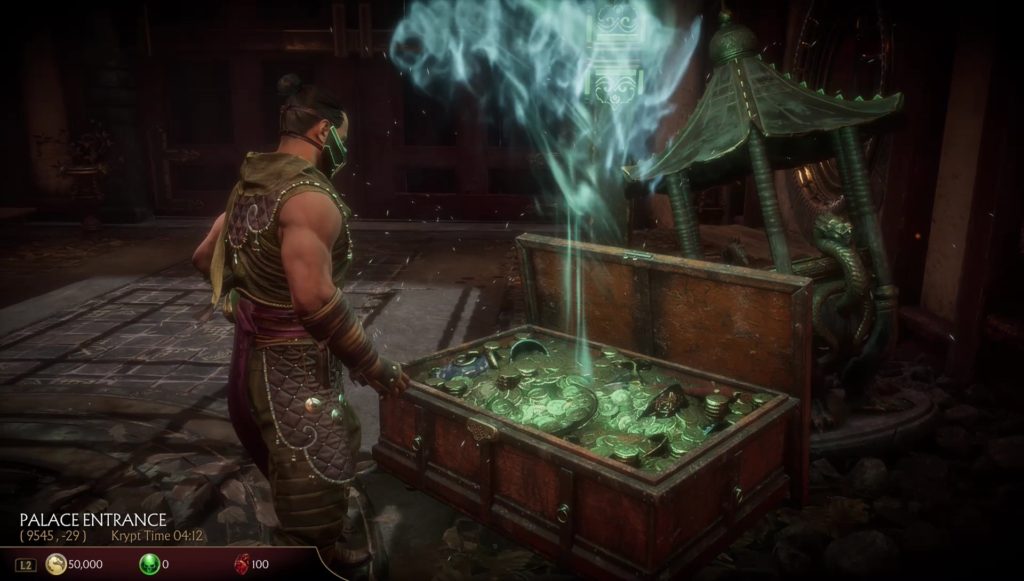
The intent of these loot boxes is clearly to ensure that players don’t just look up the locations of their desired cosmetics online, and then stop engaging with the cosmetic unlocks altogether, and it succeeds at this aim to an irritating degree. Since most players will likely choose a main or a secondary fighter to play as and just stick with them for online play, this means that in you will only be looking for one set of items, and constantly be getting the unlockables of the other combatants. However, things get far, far worse. The only way to open these chests is to spend an in-game currency which mostly must be earned through the gauntlets of pain known as Towers. The Towers are a series of CPU fights where the player must contest with various powered-up enemies. Some of these power-ups feel as though they break the balance of the game, such as giving foes armor on all moves or spawning unblockable projectiles that materialize out of the air. The fact that you have to play through these frustrating challenges, only to get a chance at unlocking the item you want is completely baffling and makes me regret ever engaging with either of these modes in the first place. The process of earning currency and getting your desired items is painfully slow, and you can open every single chest in the Krypt and not get all of the items. To keep hunting for your desired collectibles you must pay more gold to re-stock the chests.
While it would be easy to chalk up this system as a shameless cash-grab, the weird part is that there aren’t even good ways to shortcut the system with micro-transactions. Although there is a very small rotating store of in-game items that use a currency which can be purchased with real-world money, the small size of the store means that most players will still have to engage with this broken economy to get the stuff they want. Although this means that it is more likely that NetherRealms may tweak the balance of unlockables in the future, the current state of unlocking cosmetic items is quite busted.
Despite the irritating progression systems, Mortal Kombat 11 is still a fighting game that I can recommend to competitive fighting game veterans, and those are just interested in the story mode. By simplifying some aspects of the combo game, while also increasing the importance of resource management and neutral, the core gameplay offers a gratifying balance of mind-games and tech-skill. The story is goofy and weirdly affecting, showcasing a particular branch of absurdity that feels most at home in the context of a video-game narrative. While I wish that I could break free of my desire to grind out the Towers for a small chance at getting a few particular cosmetics, the real reason I keep coming back is because of the engaging interplay between the game’s fundamental mechanics. It may have some egregious flaws, but Mortal Kombat 11 is the likely the most fun I’ve had with the central gameplay of a NetherRealms title to date.
Rating: 8.6/10

